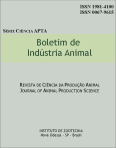Management of mulberry (Morus albaL.) under sheep browsing
Keywords:
feeding, cut frequency, forage, protein bank, pruningAbstract
The trial evaluated the herbage mass of two mulberry cultivars (IZ 13/6 and IZ 56/ 4) under browse by sheep, with plants submited to low pruning (cut at soil level) or free growth without cutting, in three periods of vegetative growth (25, 50 and 75 days). The aim of the study was to know the best mulberry management for better forage recovering. The experimental design was random blocks on a split split plot design, comparing on the principal treatments the vegetative growth forms, in the split plot the vegetative development periods and in the split split plot the mulberry cultivars. There were no differences (P>0.05) on herbage mass availability between mulberry cultivars. The free growth showed greater (P<0.05) leaves mass availability on the three growth age evaluated. There was an increase on herbage mass availability due the increase on growth age. The free growth allowed earlier recuperation of herbage mass on 50 days and when low pruned was adopted, 75 days of growth is advised. Although smaller growth age had greater crude protein content.
Downloads
Downloads
Published
Issue
Section
License
Os autores não serão remunerados pela publicação de trabalhos, pois devem abrir mão de seus direitos autorais em favor deste periódico. Por outro lado, os autores ficam autorizados a publicar seus artigos, simultaneamente, em repositórios da instituição de sua origem, desde que citada a fonte da publicação original seja Boletim de Indústria Animal. A revista se reserva o direito de efetuar, nos originais, alterações de ordem normativa, ortográfica e gramatical, com vistas a manter o padrão culto da língua e a credibilidade do veículo. Respeitará, no entanto, o estilo de escrever dos autores. Alterações, correções ou sugestões de ordem conceitual serão encaminhadas aos autores, quando necessário. Nesses casos, os artigos, depois de adequados, deverão ser submetidos a nova apreciação. As opiniões emitidas pelos autores dos artigos são de sua exclusiva responsabilidade. Todo o conteúdo deste periódico, exceto onde está identificado, está licenciado sob a Licença Creative Commons Attribution (CC-BY-NC). A condição BY implica que os licenciados podem copiar, distribuir, exibir e executar a obra e fazer trabalhos derivados com base em que só se dão o autor ou licenciante os créditos na forma especificada por estes. A cláusula NC significa que os licenciados podem copiar, distribuir, exibir e executar a obra e fazer trabalhos derivados com base apenas para fins não comerciais.













